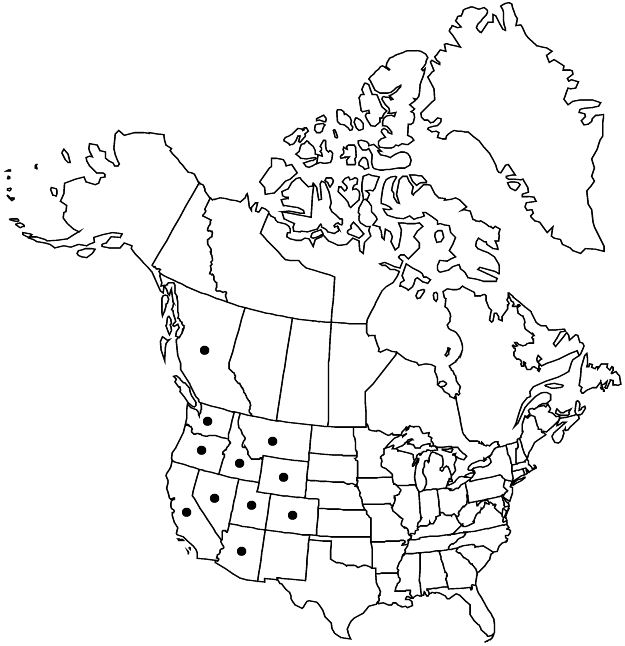Viola purpurea
Pacific (San Francisco), 2 Feb. 1855: unnumb. 1855.
Plants perennial, caulescent, not stoloniferous, 1.5–25 cm. Stems 1–5 (–7), decumbent or spreading to erect, leafy proximally and distally, ± glabrous, puberulent, canescent, or tomentose, on caudex from subligneous rhizome. Leaves basal and cauline; basal: 1–6; stipules adnate to petiole, forming 2 linear, membranous wings, wing margins entire or laciniate, each wing with lanceolate to ± deltate projection, margins entire or laciniate, apex acute to long-acuminate; petiole 1.8–14.5 cm, puberulent to tomentose; blade purplish, purple-tinted, or gray-green abaxially, gray, green, or gray-green adaxially, sometimes shiny adaxially, ovate, orbiculate, oblong, deltate, or lanceolate, 0.8–5.3 × 0.4–4.1 cm, often fleshy, base cordate, subcordate, truncate, or attenuate, oblique or not, margins usually ± crenate, serrate, dentate, or coarsely or irregularly repand-dentate, sometimes entire, usually ciliate, apex acute to obtuse or rounded, surfaces glabrous, puberulent, or tomentose; cauline similar to basal except: stipules linear, lanceolate, oblanceolate, or ± oblong to ovate, margins entire, lacerate, or laciniate, usually ciliate, apex sometimes divided into 2–3 filiform processes or obtuse; petiole 0.3–19.7 cm, glabrous or puberulent; blade ovate, oblong, elliptic, deltate, or lanceolate, 0.9–5.2 × 0.2–2.9 cm, length 0.8–7.1 times width, margins crenate, serrate, dentate, repand-denticulate, undulate-denticulate, sinuate, undulate, or entire, abaxial surface puberulent, canescent, or tomentose, adaxial surface glabrous, sparsely pubescent, puberulent, canescent, or tomentose. Capsules ovoid to ± spherical, 4–7 mm, puberulent. Seeds light to dark-brown or mottled gray and brown, 2–3.1 mm. 2n = 12.
Distribution

B.C., Ariz., Calif., Colo., Idaho, Mont., Nev., Oreg., Utah, Wash., Wyo., nw Mexico
Discussion
Varieties 7 (7 in the flora).
Varieties of Viola purpurea are variable and intergrade. All are found in California; six occur in other western states, one in Mexico, and one in British Columbia. Mature plants are needed for determination.
Selected References
None.
Lower Taxa
Key
| 1 | Basal and cauline leaf blade surfaces tomentose | Viola purpurea var. aurea |
| 1 | Basal and cauline leaf blade surfaces ± glabrous, canescent, or puberulent | > 2 |
| 2 | Stems mostly buried, not much elongated by end of season; plants 1.5–9(–12) cm | > 3 |
| 2 | Stems usually not buried, usually elongated by end of season; plants 3–25 cm | > 4 |
| 3 | Cauline leaf margins usually entire, sometimes sinuate; basal leaf margins ± crenate to irregularly repand-dentate or entire. | Viola purpurea var. integrifolia |
| 3 | Cauline leaf margins usually coarsely crenate or dentate, sometimes ± serrate or ± entire; basal leaf margins coarse-serrate or irregularly dentate or crenate with 2–4 rounded teeth per side | Viola purpurea var. venosa |
| 4 | Basal leaf base cordate or truncate | Viola purpurea var. dimorpha |
| 4 | Basal leaf base usually attenuate, sometimes subcordate or truncate | > 5 |
| 5 | Cauline leaf blade length 3.2–7.1 times width, margins usually undulate-denticulate, sometimes entire | Viola purpurea var. mesophyta |
| 5 | Cauline leaf blade length 1–3 times width, margins with 3–4(–5) pointed or rounded teeth per side or crenate-serrate | > 6 |
| 6 | Basal leaf blade margins irregularly crenate, without pointed or rounded teeth; adaxial surface often shiny. | Viola purpurea var. purpurea |
| 6 | Basal leaf blade margins dentate-serrate with 4–5(–6) pointed or rounded teeth per side; adaxial surface not shiny. | Viola purpurea var. mohavensis |
"thick" is not a number. "narrow" is not a number.